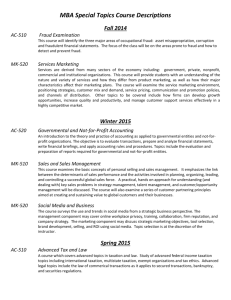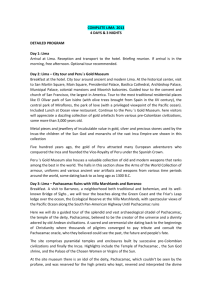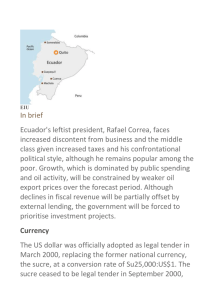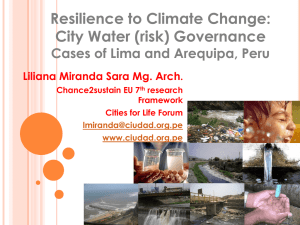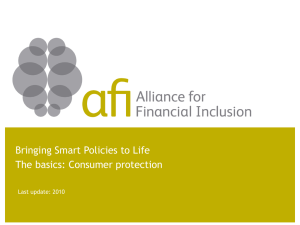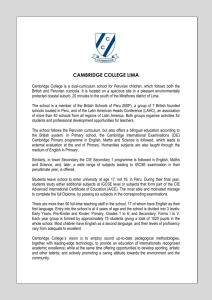Policies, Measures and Experiences Regarding Intellectual
advertisement
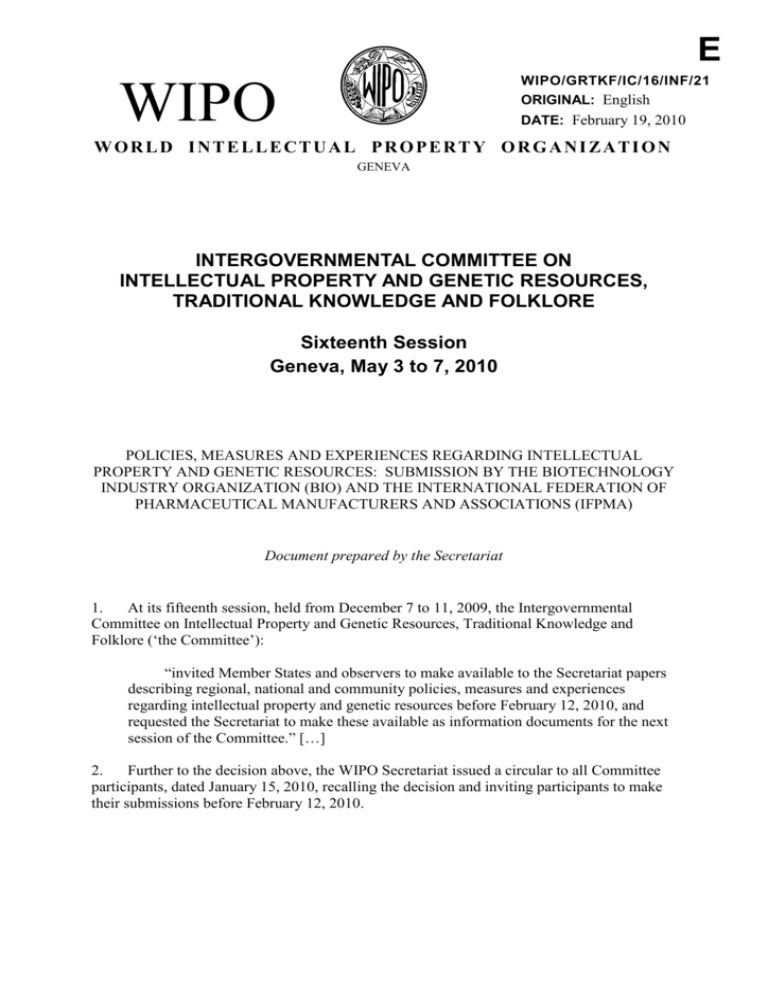
E WIPO/GRTKF/IC/16/INF/21 WIPO ORIGINAL: English DATE: February 19, 2010 WORLD INTELLECTUAL PROPERTY ORGANIZATION GENEVA INTERGOVERNMENTAL COMMITTEE ON INTELLECTUAL PROPERTY AND GENETIC RESOURCES, TRADITIONAL KNOWLEDGE AND FOLKLORE Sixteenth Session Geneva, May 3 to 7, 2010 POLICIES, MEASURES AND EXPERIENCES REGARDING INTELLECTUAL PROPERTY AND GENETIC RESOURCES: SUBMISSION BY THE BIOTECHNOLOGY INDUSTRY ORGANIZATION (BIO) AND THE INTERNATIONAL FEDERATION OF PHARMACEUTICAL MANUFACTURERS AND ASSOCIATIONS (IFPMA) Document prepared by the Secretariat 1. At its fifteenth session, held from December 7 to 11, 2009, the Intergovernmental Committee on Intellectual Property and Genetic Resources, Traditional Knowledge and Folklore (‘the Committee’): “invited Member States and observers to make available to the Secretariat papers describing regional, national and community policies, measures and experiences regarding intellectual property and genetic resources before February 12, 2010, and requested the Secretariat to make these available as information documents for the next session of the Committee.” […] 2. Further to the decision above, the WIPO Secretariat issued a circular to all Committee participants, dated January 15, 2010, recalling the decision and inviting participants to make their submissions before February 12, 2010. WIPO/GRTKF/IC/16/INF/21 Page 2 3. Pursuant to the above decision, the Biotechnology Industry Organization (BIO) and the International Federation of Pharmaceutical Manufacturers and Associations (IFPMA), accredited observers to the Committee, jointly submitted a document entitled “Joint BIO and IFPMA Submission on Regional, National and Community Policies, Measures and Experiences regarding Intellectual Property and Genetic Resources” and requested it be made available as an information document for the sixteenth session of the Committee. 4. The document is reproduced in the form received and contained in the Annex to this document. [Annexes follow] WIPO/GRTKF/IC/16/INF/21 ANNEX I JOINT BIO AND IFPMA SUBMISSION ON REGIONAL, NATIONAL AND COMMUNITY POLICIES, MEASURES AND EXPERIENCES REGARDING INTELLECTUAL PROPERTY AND GENETIC RESOURCES General Comment The Biotechnology Industry Organization (BIO) and the International Federation of Pharmaceutical Manufacturers and Associations (IFPMA) are pleased to submit these comments, and the attached papers, in response to the invitation from the Fifteenth Session of the Intergovernmental Committee on Genetic Resources, Traditional Knowledge and Folklore (IGC) for “papers describing regional, national and community policies, measures and experiences regarding intellectual property and genetic resources” (Decision 9 of the Fifteenth Session of the IGC). We consider that the work in respect of genetic resources, along with traditional knowledge and folklore is inseparable from the objectives of the IGC. As recognized since the beginning of the IGC, the three topics of genetic resources, traditional knowledge and folklore “are closely interrelated, and none can be addressed effectively without considering the aspects of the others.”1 The IGC, therefore, should build on its prior work to achieve concrete outcomes in carrying out its mandate to “undertake text-based negotiations with the objective of reaching agreement on a text for an international legal instrument (or instruments) which will ensure the effective protection of genetic resources, traditional knowledge and traditional cultural expressions”, including: the completion of the Intellectual Property Guidelines for Access and Equitable Benefit-sharing (also referred to as the guidelines for contractual practices), contained in document WIPO/GRTKF/IC/7/9; the endorsement of pragmatic proposals to resolve the concerns that have been raised with respect to the genetic resources and intellectual property, such as adapting work already agreed for TK to the context of genetic resources (e.g., integration of prior art information sources documenting genetic resources into PCT Minimum Documentation); and the creation of a fact-based framework for discussions on proposals relating to the relationship of intellectual property and genetic resources that will address concerns raised in the IGC regarding “misappropriation,” including alleged inappropriate patenting of genetic resources. In that light, we are happy to share our experiences with the IGC and the lessons learned. Foremost, researchers and commercial entities report that, in many instances, the national regimes on access and benefit-sharing (ABS) in relation to genetic resources are not sufficiently comprehensive or clear to ensure that access to or use of genetic resources is 1 WO/GA/26/6, para. 15. WIPO/GRTKF/IC/16/INF/21 Annex I, page 2 legal. This can also lead to further uncertainty in respect of intellectual property rights that may be created in respect of inventions or other developments derived from the use of genetic resources. As a result, potential research and commercial opportunities for partnerships between established industry actors and researchers or small entities in developing countries may be thwarted. We recognize that the proposed International Regime on Access and Benefit-sharing, currently under consideration in the Convention on Biological Diversity (CBD), if successful, may help national officials clarify some aspects of their ABS regimes. However, we believe that WIPO is the only organization that can appropriately address the relationship of intellectual property and genetic resources. As evidenced in document WIPO/GRTKF/16/6 Prov., there are still many questions regarding this relationship. For example, our organizations have previously indicated that we are not supportive of proposals made to introduce new patent disclosure requirements into the patent system. There are many reasons for this. First, the proposed requirements would not achieve the stated goals, i.e., better adherence to or monitoring compliance with CBD requirements (such as appropriate access and fair and equitable benefit-sharing); and second, these requirements would introduce significant uncertainties into the patent system and would thereby undermine the incentives of patents as a catalyst for innovation. The combination of uncertainty regarding the scope of a new patent disclosure requirement coupled with potentially significant commercial consequences of its breach would inevitably and significantly reduce R&D involving genetic resources and, consequently, the innovation and benefits that would accrue from their use. However, we remain confident that concrete solutions can be reached that would (1) meet the objective of ensuring that intellectual property system and the regime for appropriate access to genetic resources, and fair and equitable benefit-sharing from their use, are mutually supportive and (2) provide legal certainty and security for commercial and other stakeholders that use genetic resources in a manner that generates benefits that may be shared. Specific Examples We have attached three Annexes to this document that provide examples of the experiences of our members for consideration by the IGC. The first document, contained in Annex A, summarizes the experience of one company, Eli Lilly and Company, that was forced to abandon plans to collaborate with a researcher in Cameroon due to the difficulty in determining the appropriate steps to access genetic resources in that country. Biotechnology and pharmaceutical companies must constantly choose between numerous research pathways, and simply do not have the resources to pursue all leads. Nonetheless, Lilly viewed a successful ABS collaboration as a worthwhile endeavor, and continued to seek an agreement with Cameroon even after the Lilly scientists who initially sought the agreement lost interest in the project. This is an example of the difficulties that good-faith actors have faced in certain jurisdictions when attempting to access genetic resources and to engage in partnerships with local researchers and small entities that would generate benefits. This also helps to underscore some of the concerns relating to uncertainties in existing ABS frameworks, or resulting from the lack thereof, that should not be incorporated into intellectual property or other laws. These uncertainties could discourage partnerships and other relationships that would generate benefits for stakeholders in both developed and developing economies. WIPO/GRTKF/IC/16/INF/21 Annex I, page 3 Annex B contains an analysis, completed in 2005, of the patents and other materials submitted by Peru to the IGC, in document WIPO/GRTKF/8/12, as evidence of “possible cases” of biopiracy. We greatly appreciate the paper from Peru as a means to facilitate discussions on this issue. Annex B of that document contains a detailed analysis of the findings in the Peruvian submission. Our findings indicate that the resources at issue in that paper were made widely and freely available by sources in Peru at that time. It is likely then, that the uses at issue resulted from materials obtained through legitimate channels of commerce with no restrictions. We believe that it is time for the IGC to dig deeper into similar statements regarding perceptions of biopiracy to determine the extent to which they present a problem and what, if any, relation there is to the intellectual property context. Annex C contains the Internet addresses for guidelines that were developed by BIO and IFPMA, respectively, relating to the collection and/or access to genetic resources. The guidelines are intended to educate BIO and IFPMA Members in respect of issues that may arise in the conduct of bioprospecting activities and to provide assistance to those Members seeking guidance. These Guidelines are intended to represent a set of “best practices” that may be pursued when engaging in bioprospecting activities. In addition, the BIO Model Material Transfer Agreement provides an outline for a transfer agreement and is consistent with the best practices set forth in the BIO Guidelines. Currently, transfers of genetic resources are not handled in a consistent manner or in a comprehensive fashion either within countries or at the international level. These documents specifically provide for prior informed consent when accessing genetic resources, and establishing mutually agreed terms for benefit-sharing based on use of those resources. In addition, the guidelines have specific sections to deal with intellectual property issues that may arise during these transactions, which may be of particular import to the IGC. We look forward to our continued, positive engagement in this process with a view toward concrete outcomes that address concerns that have been raised and that help maintain and ensure a mutually supportive relationship between the intellectual property system and mechanisms for ensuring appropriate access to genetic resources and fair and equitable benefit-sharing from their use. [Annex II follows] WIPO/GRTKF/IC/16/INF/21 ANNEX II ELI LILLY AND COMPANY – TIMELINE OF NEGOTIATIONS FOR AN ABS AGREEMENT WITH CAMEROON May 2007 – Eli Lilly and Company (Lilly) received a request for a Material Transfer Agreement (MTA) from a researcher in Cameroon. The proposed provider of plant material was a company in Yaounde. National Reports posted by Cameroon on the Convention on Biological Diversity (CBD) website state that Cameroon’s 1994 Forestry, Wildlife and Fisheries Law has several requirements that need to be met before material can be transferred out of the country. In a letter to the President of the provider company, Lilly explained that according to Cameroon Law, no person may use genetic resources from Cameroon for scientific purposes without prior authorization. According to CBD National Reports, the Law also required the payment of royalties to the State for any economic gain resulting from such research. The amount of royalty was not specified. Nonetheless, Lilly was willing to pursue this potential MTA further, with the aim of creating a successful ABS agreement. June-September 2007 – The researcher in Cameroon sent follow up letters indicating that he registered the plant with the Cameroon National Herbarium Office as the “sole owner” of the plants. He stated this would allow him to transfer the plant material out of the country. He also stated the Government would soon grant an export permit. Lilly responded on every occasion, repeating its desire to ensure full compliance with Cameroon’s requirements. November 29, 2007 – Lilly received two certificates from the Ministry of Forestry and Wildlife, purportedly authorizing the export and certifying the origin of the plant material in question. However, there was still no clarification of what royalties may have been imposed by the Government. Lilly was also unsure whether all requirements of Cameroon Law were fulfilled, and needed to ensure compliance with all obligations before accepting material. The certificates indicated they would expire after three months. That was not a reasonable time period within which to negotiate an agreement or clarify key rights and obligations imposed by Cameroon. January 2008 – A representative of Lilly met informally in Geneva with the designated CBD Focal Point from Cameroon during the Sixth Meeting of the Ad-hoc Open-ended Access and Benefit-sharing Working Group of the CBD. The Focal Point reviewed the certificates and stated that they were not correct, because they were from the wrong ministry. The Focal Point informed Lilly that Cameroon did not have a complete national law in place and expressed hope that the International Regime, under consideration in the CBD, would address deficiencies in Cameroon’s national law. February 2008 – Lilly sent a follow up letter to Cameroon’s designated National Focal Point, seeking assistance to ensure proper authorization for the collaboration with the scientist in Cameroon. Lilly received no response, and closed the files on this MTA request in May 2008 – 1 year after the process began. [Annex III follows] WIPO/GRTKF/IC/16/INF/21 ANNEX III ANALYSIS OF THE EXAMPLES OF “POTENTIAL CASES OF BIOPIRACY” SUBMITTED BY PERU IN WIPO/GRTKF/8/12 I. Summary of Findings Several general observations can be made in respect of the “potential cases of biopiracy” cited in document WIPO/GRTKF/8/12 (the Peru paper): Samples of plant materials from every category of plant cited in the Peru paper were, at the time of the analysis, available from commercial suppliers in Peru on an unrestricted basis. Only 4 patents out of 144 patent families were focused on a “pharmaceutical” or “biotechnological” invention. The most prevalent uses of these inventions were cosmetic, herbal remedies or “nutraceuticals”, or food for animal or human consumption. None of the examples concerned bioengineered products. In the vast majority of the cited patents, the focus of the invention was the plant material itself, or an extract made by crushing or mashing the plant material, and then using a solvent of some type to extract unidentified constituents from the mashed/crushed plant sample. In these patents, no effort was made to identify any particular chemical compound in the extract or the plant. Rather, the plant itself or the uncharacterized extract was characterized as being the invention. Biotechnology and pharmaceutical companies generally do not pursue these types of uncharacterized products. II. Methodology Each patent cited by in the Peru paper was reviewed. Based on this analysis, it was determined that 144 distinct patent families were involved (i.e., there were 144 “unique” patent disclosures, with 11 patents being duplicates of patent disclosures filed in other countries). One of the patent family members provided no discernable information that could be reviewed (i.e., it did not identify inventors, assignee and had no claims). In addition, US Patent 6,093,421 listed under yacon was excluded from the analysis, because the single reference to yacon in the publication was made within the title of a cited abstract (i.e., there was no “use” of a sample of the yacon plant). WIPO/GRTKF/IC/16/INF/21 Annex III, page 2 III. Commercial Sources of Materials Referenced In Peru Paper Samples of each of the types of plants referenced in the Peru paper were available at the time of the analysis from commercial suppliers in Peru on an unrestricted basis. We believe that many, if not all, were publicly available at the time the relevant patent applications were filed. The table below illustrates some of the suppliers of these samples. To our knowledge, none of these Peruvian suppliers imposed any conditions or restrictions on use of the samples of materials it was providing at that time. Hercampuri (Gentianella alborosea (Gilg) Fabris) Andina Real Exporter Botica Peru (powder & extract) Cabex S.A. Compras Peru Exportaciones de la Selva S.A. Peru Exporter (powder) Peruvian Herbs Productos Tropicales Naturistas Promedan Productos Medicos Andinos S.R.L. Reategui Siete S.A.C. Y & K Herb Suppliers Lince, Lima, Peru Lima, Peru La Molina, Lima, Peru Lince, Lima, Peru San Isidro, Lima, Peru Lima, Peru Lima, Peru Lima, Peru San Isidro, Lima, Peru Surco, Lima, Peru Lima, Peru Camu-camu (Myrciaria dubia) Cabex S.A. Compras Peru Ecoandino S.A.C. Payqu Peru Exporter (powder) Peruvian Nature Reategui Siete S.A.C. La Molina, Lima, Peru Lince, Lima, Peru Surco, Lima, Peru Surco, Lima, Peru Lima, Peru Lurin, Lima, Peru Surco, Lima, Peru Yacon (Smallanthus sonchifolius) Andina Real Exporter Cabex S.A. Compras Peru Ecoandino S.A.C. Exportaciones de la Selva S.A. Payqu Peruvian Nature Promedan Productos Medicos Andinos S.R.L. Reategui Siete S.A.C. Lince, Lima, Peru La Molina, Lima, Peru Lince, Lima, Peru Surco, Lima, Peru San Isidro, Lima, Peru Surco, Lima, Peru Lurin, Lima, Peru San Isidro, Lima, Peru Surco, Lima, Peru Caigua (Cyclanthera pedata L.) Botica Peru (powder) Cabex S.A. Ecoandino S.A.C. Promedan Productos Medicos Andinos S.R.L. Lima, Peru La Molina, Lima, Peru Surco, Lima, Peru San Isidro, Lima, Peru WIPO/GRTKF/IC/16/INF/21 Annex III, page 3 Y & K Herb Suppliers Lima, Peru Sacha Inchi (Plukenetia volubilis L.) Agroveterinaria Limaf Geka Corp. S.A.C., d/b/a Omega Life Junin, Peru Lima, Peru Chancapiedra (Phyllanthus niruri) Andina Real Exporter Botica Peru (powder & extract) Cabex S.A. Compras Peru Financial Business Corporation S.R.L. Peru Exporter Peruvian Herbs Promedan Productos Medicos Andinos S.R.L. Lince, Lima, Peru Lima, Peru La Molina, Lima, Peru Lince, Lima, Peru San Isidro, Lima, Peru Lima, Peru Lima, Peru San Isidro, Lima, Peru IV. Findings from Analysis of the Patents A. Field of Application of the Inventions The patent disclosures and claims were studied to ascertain the general field of application of the invention (i.e., in which industrial or business sector is the patented invention likely to be commercialized, if at all). The top three fields of application for the inventions described in the patents were “nutraceuticals/dietary supplements/herbal remedies” (33%), food products for human consumption (30%) and cosmetics (23%). Examples of inventions falling in the first of these categories include: extracts of plants as additives in foods, purportedly to treat a variety of conditions such as viral infections, hypertension, memory loss, diabetes, and obesity. Examples of cosmetics include: preparations to retard skin aging or lighten skin complexion. After these three, which account for more than 85% of the patents, patents had applications in farming or aquaculture (3%), pharmaceuticals (2%) and products for animal consumption or use (1%). Examples of farming/aquaculture patents include: use of yacon vinegar as an agricultural additive in the cultivation of bean sprouts and extracts of Phyllanthus urinaria and Phyllanthus amarus (species that are distinct from Phyllanthus niruri, which is the scientific name for chancapiedra) to treat a virus that affects shrimp. The two examples of products for animal consumption or use both describe using inulin, which can be extracted from yacon (but the claims specifically cite chicory as the preferred source for the inulin), as a food bulking agent. Approximately 8% of the patents concerned process inventions which had no clearly identifiable industrial application, other than to process the materials in question. None of the patents reviewed describes any uses or applications of the plant materials in a “biotechnological” process. In other words, none of these patents involve situations where there was a manipulation of the genetic characteristics of the plant or use of the genetic information from the plant. None of these patents, thus, could be characterized as being within the biotechnology industry. Rather, the vast majority of the inventions described in these patents are based directly on the plant material itself, or something isolated by extracting substances from the materials. WIPO/GRTKF/IC/16/INF/21 Annex III, page 4 Industrial Application of the Invention Process or method only / No product claims (12) 8% Farming/Aquaculture (4): 3% Pharmaceuticals (3): 2% Food for human consumption (43): 30% Nutraceutical / Dietary supplements / Herbals (46): 33% Products for animal use / consumption (2): 1% Cosmetics (33): 23% B. Nature of Use of the Materials and Relationship to Claimed Invention The patent disclosures were analyzed to determine how source materials were used in developing the invention, and to understand how the inventions claimed in the patents relate to the source material. The most prevalent type of use was where the materials were crushed or mashed, and then treated with an aqueous or non-aqueous solvent. This yielded an extract from the plant which was described as the invention. In these examples, the individual constituents of the extract were not isolated or characterized; rather, the invention was the extract (i.e., a composition of unknown character). In approximately 63% of the patents, this was what the claimed invention was or how it was made. The second most prevalent nature of use of the materials were inventions characterized as being the whole plant or a fruit from the plant, or a juice or powder derived from the plant. In these examples, the “invention” was not extracted from the plant, but was the plant itself or a component of the plant. Approximately 29% of the patents fell into this category. Only about 4% of the patents (i.e., a total of 6 patents) were directed to isolation of a specific chemical compound from the material. In these examples, a process was followed where the materials were crushed, an extract created, and then additional steps taken to isolate and characterize the individual chemical compounds from the extract. The final category involved process inventions where materials were treated through sequence of processing steps. These did not yield compositions or products. Approximately 3% of the patents fell into this category. WIPO/GRTKF/IC/16/INF/21 Annex III, page 5 As noted above, none of these patents involved the use of “biotechnology” techniques (i.e., concerning manipulation of the genetic information of the plant). As such, none of the patents concerned an invention in the field of biotechnology. Nature of Claimed Invention and Relationship to Source Material Process or method only / No product claims, 4, 3% Unknown claims, 1, 1% Isolated compound from plant, 6, 4% Whole plant or fruit / Powder / Juice, 45, 29% Extracts from plant, 98, 63% C. Patents Owned by Pharmaceutical or Biotechnology Companies We analyzed the patents in an attempt to identify the proportion of the patents that were owned by established pharmaceutical or biotechnology companies. To do so, we determined which of the patents were owned by an entity that was a member of BIO, of PhRMA, or of pharmaceutical or biotechnology industry associations in Japan or European countries. Only a small fraction of the total number of patents were owned by biotechnology or pharmaceutical companies. WIPO/GRTKF/IC/16/INF/21 Annex III, page 6 Ownership of Patents BIO - Japan, 15, 10.4% BIO - US, 4, 2.8% BIO - India, 1, 0.7% JPMA Members, 2, 1.4% Others, 122, 84.7% V. Concluding Observations The disclosure obligations under consideration in the IGC would apply to any patent application for an invention in which a biological and/or genetic resource is “used.”2 The precise nature of the obligations that might apply to each patent applicant varies based on the proposals. Assuming that these proposals would apply as described (i.e., to any patent disclosure that references any sample of any type of living material), the obligation would apply to a large number of applications. The Peru paper identifies a total of 144 distinct patent families based on their comprehensive search of patents in the Japanese, U.S. and other patent databases. This reflects a total of 144 examples of patents over a roughly 25-30 year period. During this same time period, the U.S. issued more than 803,630 patents in the chemical sector.3 The 144 patent families identified by Peru thus represents roughly 0.018% of the total number of “chemical” (including biotechnology) patents that were issued by the PTO in that same time period. Under the proposals made, patent applicants would have to make additional, burdensome disclosures in a huge number of chemical patent applications. This is because See WIPO/GRTKF/8/12, note 2, citing Peru’s submissions to the World Trade Organization, including IP/C/W/420, which uses this formulation. A more recent textual proposal from 2006 uses the expression “where the subject matter of a patent application concerns, is derived from or developed with biological resources and/or associated traditional knowledge.” (IP/C/W/474). 3 http://www.uspto.gov/web/offices/ac/ido/oeip/taf/stchem.htm#PartA1_1 2 WIPO/GRTKF/IC/16/INF/21 Annex III, page 7 applications in the chemical field frequently mention biological or genetic resources where there is some relation of such resources to the invention. This significant, unjustified burden would be imposed, even though only a tiny fraction of these applications would pertain in any way to Peru’s and other countries’ interests under the CBD. The burden would be even heavier on the pharmaceutical and biotechnology companies and could place many projects at risk, despite the fact that there is no evidence these companies are inappropriately using genetic resources. More importantly, the burden would be imposed despite the fact that in every example cited by Peru, samples of the plants that Peru is claiming were the subject of possible “biopiracy” are available from Peruvian suppliers on an unrestricted basis. Thus, it is likely that materials were obtained in legitimate channels of commerce. It is difficult to justify creation of new, complex international regulatory regime to “police” uses of these “genetic resources” where governments do not implement national laws to prevent companies or entities within their territorial borders from freely exporting samples without restriction as to their use. Indeed, the unrestricted nature of access that was provided through the domestic suppliers strongly suggests that users of the samples had no reason to believe there were any further requirements associated with their use of the materials. Table I. Analysis of Patents, by Country of Filing and Type of Resource Hercampuri 12 12 12 Camu-camu 19 19 19 Yacon 74 72 65 Caigua 1 1 1 Chancapiedra 53 50 47 TOTAL 159 154 144 Japan United States Korea PCT China Europe Russia United Kingdom Ireland Australia Germany TOTAL Hercampuri 11 1 0 0 0 0 0 0 0 0 0 12 Camu-camu 16 2 0 1 0 0 0 0 0 0 0 19 Yacon 50 10 3 1 0 0 1 0 0 0 0 65 Caigua 0 1 0 0 0 0 0 0 0 0 0 1 Chancapiedra 14 22 2 2 2 1 0 1 1 1 1 47 TOTAL 91 36 5 4 2 1 1 1 1 1 1 144 WIPO/GRTKF/IC/16/INF/21 Annex III, page 8 RESOURCE Total publications cited by Peru Net number of publications Net number of publications, by family Table II. Patents Owned by Association Members Hercampuri 2 2 Camu-camu 0 Yacon 2 Caigua 0 Chancapiedra 11 4 TOTAL 15 2 0 0 0 1 1 0 0 0 0 0 0 0 0 0 0 2 0 0 0 0 0 2 0 0 1 6 1 3 3 1 1 2 1 1 0 0 17 4 1 2 1 1 0 0 22 WIPO/GRTKF/IC/16/INF/21 Annex III, page 9 BIO Members' # of Patent Families BIO – Japan Shiseido Corp. Ltd. KAO Corp. Lion Corp. Yakult Honsha Co. Ltd. BIO – US Virginia Tech Intellectual Properties Fox Chase Cancer Center BIO – India Southern Petrochemical JPMA Members Senju Pharmaceutical Co., Ltd. Tsumura & Co. PhRMA – US PhRMA – India TOTAL Table III. Industrial Field of Application of the Patented Invention Camu-camu 7 9 11 Yacon 36 2 3 1 1 15 0 3 6 1 12 19 65 1 2 Caigua Chancapiedra 10 TOTAL 43 2 33 29 3 1 3 1 47 46 3 4 12 1 144 WIPO/GRTKF/IC/16/INF/21 Annex III, page 10 Food for human consumption Products for animal use / consumption Cosmetics Nutraceutical / Dietary supplements / Herbals Pharmaceuticals Farming/Aquaculture Process or method only / No product claims Unknown claims (Irish application) TOTAL Hercampuri Table IV. Relationship Between Source Material and Invention Hercampuri Whole plant or fruit / Powder / Juice Extracts from plant Isolated compound from plant Process or method only / No product claims Unknown claims (Irish application) TOTAL 12 Camu-camu 6 12 1 12 19 Yacon 37 24 2 2 65 Caigua 0 1 0 Chancapiedra 2 40 4 1 1 47 TOTAL 45 89 6 3 1 144 WIPO/GRTKF/IC/16/INF/21 Annex III, page 11 [Annex IV follows] WIPO/GRTKF/IC/16/INF/21 ANNEX IV INDUSTRY BIOPROSPECTING GUIDELINES The Guidelines for BIO Members Engaging in Bioprospecting are available at http://www.bio.org/ip/international/200507guide.asp. The BIO Suggested Model Material Transfer Agreement is available at http://www.bio.org/ip/international/BIO_Model_MTA.pdf. The Guidelines for IFPMA Members on Access to Genetic Resources and Equitable Sharing of Benefits Arising Out of their Utilization are available at http://www.ifpma.org/Issues/fileadmin/templates/ifpmaissues/pdfs/2008_05_22_Guidelines_ Genetic_Resources_EN.pdf. [End of Annexes and of document]
